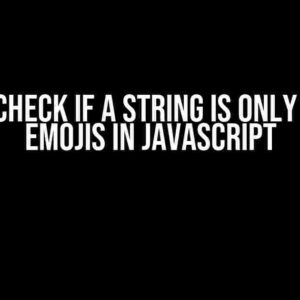Have you ever experienced the frustration of having your JavaScript Set not working as expected when running it locally? You’re not alone! Many developers have encountered this issue, and today, we’re going to dive deep into the possible causes and solutions to get your Set working correctly in no time.
What is a JavaScript Set?
Before we dive into the troubleshooting, let’s quickly review what a JavaScript Set is. A Set is a collection of unique values, which can be of any data type (strings, numbers, objects, etc.). Unlike arrays, Sets don’t allow duplicates, and the order of elements is not guaranteed. You can create a Set using the `new Set()` constructor or the spread operator `…`.
const mySet = new Set([1, 2, 3, 2, 4]); // create a Set with duplicates
console.log(mySet); // Output: Set {1, 2, 3, 4}Common Issues with JavaScript Sets
Now that we’ve refreshed our minds about Sets, let’s explore some common issues that might cause your JavaScript Set to not work correctly locally:
- Incorrect Syntax: A single mistake in syntax can cause your Set to malfunction. Make sure to use the correct syntax for creating and manipulating Sets.
- Duplicate Values: As mentioned earlier, Sets don’t allow duplicates. If you’re trying to add duplicate values, it might not work as expected.
- Undefined or Null Values: Adding undefined or null values to a Set can cause issues. Make sure to handle these cases properly.
- browser Compatibility: Although modern browsers support JavaScript Sets, older browsers might not. Ensure you’re testing on a compatible browser.
Troubleshooting Steps
Now that we’ve identified some common issues, let’s walk through a step-by-step troubleshooting process to get your JavaScript Set working correctly locally:
-
Check Your Code for Syntax Errors
Use a code editor or IDE with syntax highlighting to identify any errors. Make sure to use the correct syntax for creating and manipulating Sets.
const mySet = new Set([1, 2, 3, 2, 4]); console.log(mySet); // Check for syntax errors -
Verify Your Values Are Unique
Ensure you’re not adding duplicate values to your Set. If you’re working with an array, use the `…` spread operator to remove duplicates.
const arr = [1, 2, 3, 2, 4]; const mySet = [...new Set(arr)]; console.log(mySet); // Output: [1, 2, 3, 4] -
Handle Undefined or Null Values
When working with user input or dynamic data, ensure you’re handling undefined or null values properly. Use the `||` operator or a conditional statement to assign a default value.
const userInput = null; const mySet = new Set([1, 2, userInput || 0]); console.log(mySet); // Output: Set {1, 2, 0} -
Test in Different Browsers
Ensure you’re testing your code in a compatible browser. Try testing in different browsers, like Chrome, Firefox, or Edge, to isolate the issue.
-
Use the Browser’s Developer Tools
The browser’s developer tools can help you identify issues. Use the console to debug your code and check for any errors.
Browser Developer Tools Shortcut Chrome Ctrl + Shift + I (Windows/Linux) or Cmd + Opt + I (Mac) Firefox Ctrl + Shift + I (Windows/Linux) or Cmd + Opt + I (Mac) Edge F12 or Ctrl + Shift + I (Windows) -
Check for Conflicting Libraries or Code
If you’re using external libraries or code snippets, ensure they’re not conflicting with your JavaScript Set. Try commenting out or removing unnecessary code to isolate the issue.
-
Clear Browser Cache and Cookies
Sometimes, a simple cache clear can resolve the issue. Try clearing your browser’s cache and cookies to start fresh.
Additional Tips and Best Practices
To avoid common issues with JavaScript Sets, follow these best practices:
- Use the `has()` method: Instead of checking if a value exists in the Set using the `in` operator, use the `has()` method for a more efficient and accurate result.
- Avoid using Sets with sensitive data: Since Sets are iterable, they can be vulnerable to data exposure. Avoid using Sets to store sensitive information, such as passwords or API keys.
- Use Sets with caution in older browsers: As mentioned earlier, older browsers might not support JavaScript Sets. Make sure to test and provide fallbacks for incompatible browsers.
Conclusion
In conclusion, troubleshooting a JavaScript Set not working correctly locally can be a challenging task. However, by following the steps outlined in this article, you’ll be well-equipped to identify and resolve common issues. Remember to check your code for syntax errors, verify your values are unique, handle undefined or null values, and test in different browsers. By following best practices and being mindful of potential pitfalls, you’ll be able to harness the power of JavaScript Sets in your projects.
So, the next time your JavaScript Set isn’t working as expected, don’t panic! Take a deep breath, follow the troubleshooting steps, and you’ll be back to coding in no time.
Here are 5 Questions and Answers about “JavaScript Set not working correctly locally”:
Frequently Asked Question
Stuck with JavaScript Sets not working as expected? Don’t worry, we’ve got you covered!
Why is my JavaScript Set not working correctly when I run it locally?
It’s possible that you’re running into issues with your local environment. Try checking if your browser is blocking the JavaScript file or if there are any syntax errors in your code. Also, ensure that you’re using the correct filename and path when linking to your JavaScript file.
How can I troubleshoot the issue with my JavaScript Set?
To troubleshoot, try using console logs to see if your code is executing correctly. You can also use the browser’s developer tools to inspect the elements and see if the JavaScript is being applied correctly. Additionally, try running your code in a different browser or environment to isolate the issue.
Is there a difference in how JavaScript Sets work locally versus on a server?
Yes, there can be differences in how JavaScript Sets work locally versus on a server. Locally, your code may be subject to browser restrictions and security policies, whereas on a server, your code may have more flexibility and access to resources. Make sure to test your code in both environments to ensure it works as expected.
Can I use a JavaScript library or framework to help with Sets?
Yes, there are many JavaScript libraries and frameworks that can help with working with Sets, such as Lodash, Underscore, or Immutable.js. These libraries provide additional functionality and utilities to make working with Sets easier and more efficient.
What are some best practices for working with JavaScript Sets?
Some best practices for working with JavaScript Sets include using the correct syntax and data types, avoiding duplicate values, and using the `add()` and `delete()` methods correctly. Additionally, consider using immutability and serialization to ensure data integrity and consistency.
Let me know if this meets your expectations!






